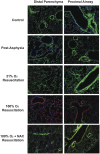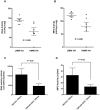Antioxidant protects against increases in low molecular weight hyaluronan and inflammation in asphyxiated newborn pigs resuscitated with 100% oxygen
- PMID: 22701723
- PMCID: PMC3372475
- DOI: 10.1371/journal.pone.0038839
Antioxidant protects against increases in low molecular weight hyaluronan and inflammation in asphyxiated newborn pigs resuscitated with 100% oxygen
Abstract
Background: Newborn resuscitation with 100% oxygen is associated with oxidative-nitrative stresses and inflammation. The mechanisms are unclear. Hyaluronan (HA) is fragmented to low molecular weight (LMW) by oxidative-nitrative stresses and can promote inflammation. We examined the effects of 100% oxygen resuscitation and treatment with the antioxidant, N-acetylcysteine (NAC), on lung 3-nitrotyrosine (3-NT), LMW HA, inflammation, TNFα and IL1ß in a newborn pig model of resuscitation.
Methods & principal findings: Newborn pigs (n = 40) were subjected to severe asphyxia, followed by 30 min ventilation with either 21% or 100% oxygen, and were observed for the subsequent 150 minutes in 21% oxygen. One 100% oxygen group was treated with NAC. Serum, bronchoalveolar lavage (BAL), lung sections, and lung tissue were obtained. Asphyxia resulted in profound hypoxia, hypercarbia and metabolic acidosis. In controls, HA staining was in airway subepithelial matrix and no 3-NT staining was seen. At the end of asphyxia, lavage HA decreased, whereas serum HA increased. At 150 minutes after resuscitation, exposure to 100% oxygen was associated with significantly higher BAL HA, increased 3NT staining, and increased fragmentation of lung HA. Lung neutrophil and macrophage contents, and serum TNFα and IL1ß were higher in animals with LMW than those with HMW HA in the lung. Treatment of 100% oxygen animals with NAC blocked nitrative stress, preserved HMW HA, and decreased inflammation. In vitro, peroxynitrite was able to fragment HA, and macrophages stimulated with LMW HA increased TNFα and IL1ß expression.
Conclusions & significance: Compared to 21%, resuscitation with 100% oxygen resulted in increased peroxynitrite, fragmentation of HA, inflammation, as well as TNFα and IL1ß expression. Antioxidant treatment prevented the expression of peroxynitrite, the degradation of HA, and also blocked increases in inflammation and inflammatory cytokines. These findings provide insight into potential mechanisms by which exposure to hyperoxia results in systemic inflammation.
Conflict of interest statement
Figures









References
-
- Bryce J, Boschi-Pinto C, Shibuya K, Black RE. WHO estimates of the causes of death in children. Lancet. 2005;365:1147–1152. - PubMed
-
- Alonso-Spilsbury M, Mota-Rojas D, Villanueva-Garcia D, Martinez-Burnes J, Orozco H. Perinatal asphyxia pathophysiology in pig and human: a review. Animal reproduction science. 2005;90:1–30. - PubMed
-
- Obladen M. History of neonatal resuscitation. Part 2: oxygen and other drugs. Neonatology. 2009;95:91–96. - PubMed
-
- Saugstad OD, Ramji S, Soll RF, Vento M. Resuscitation of newborn infants with 21% or 100% oxygen: an updated systematic review and meta-analysis. Neonatology. 2008;94:176–182. - PubMed
-
- Richmond S, Goldsmith JP. Refining the role of oxygen administration during delivery room resuscitation: what are the future goals? Seminars in fetal & neonatal medicine. 2008;13:368–374. - PubMed
Publication types
MeSH terms
Substances
LinkOut - more resources
Full Text Sources
Medical
Research Materials

